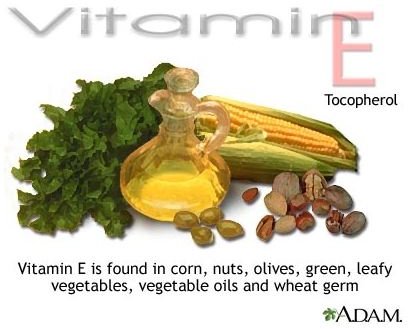Health Benefits of Vitamin E
Health Benefits
Vitamin E is a fat-soluble vitamin and exists in eight different forms. In humans, alpha-tocopherol is the most active form. It is a powerful antioxidant and plays a major role in destroying free radicals. Because it protects cells from free radicals, some important benefits of vitamin E include the possibility of slowing the aging process and protecting the body from age-related diseases, such as cancer, heart disease, macular degeneration, and cataracts.
Other possible health benefits include preventing or treating male infertility, asthma, Parkinson’s disease, gout, premenstrual syndrome, menopause, multiple sclerosis, diabetes, epilepsy, pregnancy-induced hypertension, peptic ulcers, Graves’ disease, osteoarthritis, rheumatoid arthritis, acne, vaginitis, Alzheimer’s disease, inflammatory bowel disease, fibrocystic breast disease, and migraines.
Deficiency
Vitamin E deficiency is not that common because it is so widespread in food and because the body stores large amounts of vitamin E in fatty tissues. However, there are exceptions:
• Individuals who are extremely malnourished.
• People with certain disorders, such as cystic fibrosis and Crohn’s disease. These conditions can interfere with the absorption of vitamin E. To prevent vitamin E deficiency in these individuals, a specialized water-soluble vitamin E supplement is prescribed.
• Premature infants. There is little transfer of vitamin E from the mother to the fetus until the very last weeks of pregnancy.
Toxicity
There is no documented research on vitamin E toxicity from food sources alone but it has been shown that high doses of vitamin E supplements can cause toxic effects, including muscle weakness, intestinal cramps, diarrhea, and double vision. Recent studies suggest that high doses of vitamin E over a long period of time may increase the risk of developing heart disease and cancer.
Dosages
The US Recommended Dietary Allowance (RDA) for vitamin E:
- infants (0-6 months) 4 mg (6 IU)
- infants (7-12 months) 5 mg (7.5 IU)
- children (1-3 years) 6 mg (9 IU)
- children (4-8 years) 7 mg (10.5 IU)
- children (9-13 years) 11 mg (16.5 IU)
- males and females (14+ years) 15 mg (22.5 IU)
- pregnant females (9+ years) 15 mg (22.5 IU)
- lactating females (9+ years) 19 mg (28.5 IU)
Foods
Wheat germ, nuts and seeds, vegetable oils, liver, leafy green vegetables, avocados, egg yolk, whole grains, papaya, olives, kiwi, tomatoes, blueberries, and mangoes are some foods high in vitamin E.
Health benefits of vitamin E are best from food sources and not supplements.
Photo Credit
Image courtesy of the National Library of Medicine (NLM).
Disclaimer
Please read this disclaimer regarding the information contained within this article.
